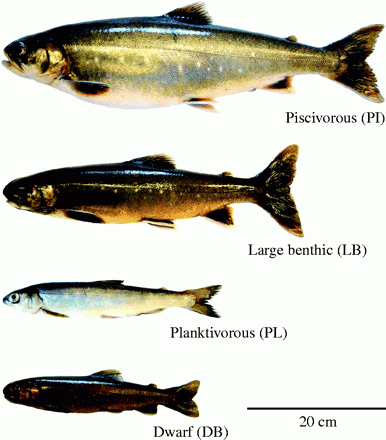One of Iceland’s most beautiful destinations, and the first stop on the “Golden Circle” is Þingvellir National Park. The park, which is located about 40 km (25 miles) northeast of Iceland's capital, Reykjavík, is a site of historical, cultural, and geological significance. It is safe to say that no place in all of Iceland has a similar significance to Icelanders.
1) First national park in Iceland

Þingvellir, the site of the ancient parliament of the Viking commonwealth, is probably the single most important historic site in Iceland. It played a central role in the Icelandic independence struggle, seen as the birthplace of the nation and its “holiest” sites. It was therefore a deeply symbolic act that the Icelandic parliament in 1928 approved a law declaring Þingvellir a National Park in the year 1930, on the 1000 anniversary of the foundation of Alþingi.
In 2004 Þingvellir was then declared a Unesco world heritage site. In a certain understatement the Unesco World Heritage Site explains the significance of Þingvellir in these terms: „The Althing has deep historical and symbolic associations for the people of Iceland.“
2) Icelanders declared independence from Denmark in Þingvellir

When Þingvellir was declared a national park Iceland had still not achieved full independence from Denmark. In 1904 Iceland had been granted home rule and in 1918 Iceland became a sovereign state within the Danish Kingdom, with the Danish king as the head of state. When Iceland was declared a republic in 1944 it was done at Þingvellir.
The ceremony was held on June 17, the birthdate of Jón Sigurðsson, the 19th century leader of the Icelandic Independence movement.
3) The site of the parliament of the Viking Age commonwealth
The name Þingvellir translates as “the fields of parliament”, as it was the site of Alþingi, the democratic legislative assembly, highest court and most important political institution of the of the Viking Age commonwealth.
According to the written account of the Viking Age settlement of Iceland the first settler, Ingólfur Arnarson arrived in 874 with his family and team members in present day Reykjavík. The settlers adopted a form of democratic organization common to Germanic societies, the þing.
The first Icelandic þing was Kjalarnesþing, a regional assembly established by the son of Ingólfur in present day Reykjavík shortly after 900.

In the year 930 Alþingi, the “þing of all”, as the highest of the regional þing was then founded at Þingvellir. The site was chosen because of its accessibility to the most populous regions in the north, south and west Iceland.
Read more: News report: The Viking Age settlement that is emerging in downtown Reykjavík
As the population of Iceland had grown it became necessary to create a political institution which could establish a standardized body of law to govern the new society. The fact that the settlers of Iceland came from various different Norse settlements in Scandinavia and the British Isles, each bringing with him a his own customary laws, made it even more pressing to have a unified law for the entire new nation. In this way Þingvellir became the birthplace of a unified Icelandic nation.
4) An open air assembly, conducted by Almannagjá gorge
Alþingi was an open-air assembly, with all business conducted in the slope and fields in front of Lögberg, The law-rock which provided a natural platform for holding speeches. The business of Alþingi began with the Lögsögumaður, The Law-sayer, reciting the laws from memory at Lögberg.
Following this the Goðar, the chieftains, accompanied by their þingmenn, men of Parliament, would deliberate and settle disputes.

During the Viking Age commonwealth parliament remained in session for a couple of weeks. With hundreds, even thousands, of people gathered at Alþingi it as the centre of life in Iceland. Tents and huts were erected in the fields below Almannagjá gorge to house the guests.
In addition to a legislative assembly Alþingi was a court, and a gathering of the entire nation, where deals were struck, alliances formed and feasts held. Some of the most important scenes in the Sagas take place at Alþingi. It was the focal point of Viking Age Iceland.
Read more: 7 things you didn't know about Alþingishúsið, the house of parliament
Alþingin continued to meet in Þingvellir until 1798. It 1844 it was moved to Reykjavík, finally receiving a permanent home in downtown Reykjavík in the newly erected house of parliament in 1881.
5) It is constantly expanding
The entire Þingvellir region is located in a rift valley created by the drifting apart of the North American and Eurasian tectonic plates.
The tectonic plates are drifting in opposite direction at the rate of 2cm (0.8 in) annually.
The plate boundary runs through Iceland. In Reykjanes peninsula the plates inch past each other at a constant rate, but at Þingvellir, they move in opposite directions, breaking apart. This causes the land between them to subside.
Read more: Beautiful video of snorkelling in crystal clear waters in lava fissure in Þingvellir national park

The 7.7 km (4.8 mile) long Almannagjá gorge on the west edge of the Þingvellir National Park, where the Viking age commonwealth parliament Alþingi met, marks the western edge of the valley. Heiðagjá gorge on the east edge of Þingvellir marks the eastern edge of the rift valley.
6) You can dive between the continents
The many gorges have filled with crystal clear spring water. The water has been filtered by the lava and volcanic rocks, which it seeps through on its way down from the mountains and Langjökull glacier to the north of Þingvellir.

One of the gorges, Silfra, has become a popular destination for travellers who snorkel or dive in its clear water, enjoying the view of beautiful natural formations in the gorge and the amazing feeling of swimming right between the two continental plates.
7) The valley is subsiding and expanding
The valley has subsided by at least 4 meters (12 ft) since Iceland was settled. As the entire rift valley has subsided the shore of the lake has moved further to the North. At the same time the valley edges have drifted apart. The expansion of the valley since Iceland was settled is somewhere around 8.5 meters (28 ft).
The movement of the tectonic plates is not constant in Þingvellir, as it is in Reykjanes peninsula. At Þingvellir the movement takes place in busts, as tensions build up and the movement taking place in bursts of major earthquakes and subsiding of the valley.
Read more: Powerful earthquake swarm south of Þingvellir over after 170 quakes: What happened?

The most recent burst of activity swept over Þingvellir in spring 1789. The valley subsided 1-2 meters (3-6 ft) during this episode. Periodically the valley has then been filled with lava in eruptions of nearby volcanoes. The last eruption took place 2000 years ago.
The entire area is still highly active geologically and the question is not whether, but when, the next major eruption takes place.
8) Þingvallavatn lake: Iceland’s largest lake
In the southern part of the valley is Þingvallavatn lake. With a surface area of 84 km2 and a depth of 114 m (374 ft) it is the largest natural lake in Iceland. One river runs into Þingvallavatn, Öxará, which runs through Almannagjá gorge, but it is primarily fed by groundwater.
The majority of the catchment area is covered by lava and water easily drains through. The young age of the lava means that there is a high uptake of minerals in the groundwater, and this is one of the reasons for the great diversity of life in Þingvallavatn.
The lake is particularly fertile and rich in vegetation, despite the very cold temperatures. A total of 150 types of plants have been found and 50 kinds of invertebrates, from the shore to the center.
9) Unique char popularion

The Arctic Charr population of Þingvallvatn is completely unique in the world, as no lake is home to as many distinct types (morphs) of charr. Four different types of Arctic Charr live in Þingvallvatn, each adapted to a specific habitat in the lake.
The char Lake Þingvallavatn have evolved and adapted to their surroundings since the population became isolated at the end of the last Ice Age, 10,000 years ago.
Arctic charr is a cold-water fish in the family Salmonidae, (Salmon and trout also belong to the salmonidae family). Char are native to alpine and subarctic lakes as well as arctic and subarctic coastal waters. In Icelandic char is called Bleikja, a feminine form of the word for the color pink, bleikur.
Read more: Þingvellir featured in first episode of Season 4 of Game of Thrones
The four types of char in Þingvallavatn are Silableikja, a fish-eating type, piscivorous charr which lives close to the surface and in shallow regions. It can grow up to 40 centimetres in length. A second type of char shares this habitat, but primarily eats plants, Murta, the plant-eating, or planktivorous charr. It is significantly smaller, usually only about 20 centimetres in length.
The lake bottom, which is rich in food and places to hide from predators, is the main habitat of the large snail-eating charr and a morph of dwarf-charr. The snail-eating charr can grow to be up to 50 centimetres in length, while the dwarf-charr is usually only 10-13 centimetres.

One of Iceland’s most beautiful destinations, and the first stop on the “Golden Circle” is Þingvellir National Park. The park, which is located about 40 km (25 miles) northeast of Iceland's capital, Reykjavík, is a site of historical, cultural, and geological significance. It is safe to say that no place in all of Iceland has a similar significance to Icelanders.
1) First national park in Iceland

Þingvellir, the site of the ancient parliament of the Viking commonwealth, is probably the single most important historic site in Iceland. It played a central role in the Icelandic independence struggle, seen as the birthplace of the nation and its “holiest” sites. It was therefore a deeply symbolic act that the Icelandic parliament in 1928 approved a law declaring Þingvellir a National Park in the year 1930, on the 1000 anniversary of the foundation of Alþingi.
In 2004 Þingvellir was then declared a Unesco world heritage site. In a certain understatement the Unesco World Heritage Site explains the significance of Þingvellir in these terms: „The Althing has deep historical and symbolic associations for the people of Iceland.“
2) Icelanders declared independence from Denmark in Þingvellir
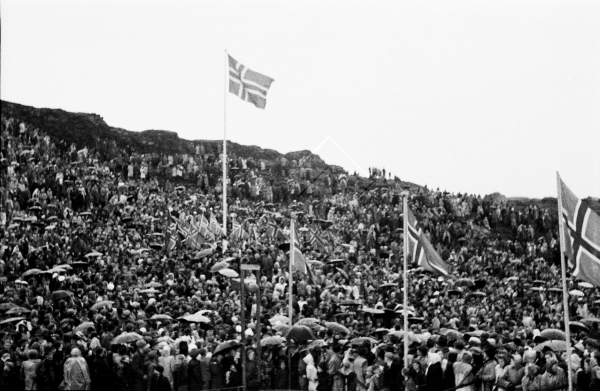
When Þingvellir was declared a national park Iceland had still not achieved full independence from Denmark. In 1904 Iceland had been granted home rule and in 1918 Iceland became a sovereign state within the Danish Kingdom, with the Danish king as the head of state. When Iceland was declared a republic in 1944 it was done at Þingvellir.
The ceremony was held on June 17, the birthdate of Jón Sigurðsson, the 19th century leader of the Icelandic Independence movement.
3) The site of the parliament of the Viking Age commonwealth
The name Þingvellir translates as “the fields of parliament”, as it was the site of Alþingi, the democratic legislative assembly, highest court and most important political institution of the of the Viking Age commonwealth.
According to the written account of the Viking Age settlement of Iceland the first settler, Ingólfur Arnarson arrived in 874 with his family and team members in present day Reykjavík. The settlers adopted a form of democratic organization common to Germanic societies, the þing.
The first Icelandic þing was Kjalarnesþing, a regional assembly established by the son of Ingólfur in present day Reykjavík shortly after 900.

In the year 930 Alþingi, the “þing of all”, as the highest of the regional þing was then founded at Þingvellir. The site was chosen because of its accessibility to the most populous regions in the north, south and west Iceland.
Read more: News report: The Viking Age settlement that is emerging in downtown Reykjavík
As the population of Iceland had grown it became necessary to create a political institution which could establish a standardized body of law to govern the new society. The fact that the settlers of Iceland came from various different Norse settlements in Scandinavia and the British Isles, each bringing with him a his own customary laws, made it even more pressing to have a unified law for the entire new nation. In this way Þingvellir became the birthplace of a unified Icelandic nation.
4) An open air assembly, conducted by Almannagjá gorge
Alþingi was an open-air assembly, with all business conducted in the slope and fields in front of Lögberg, The law-rock which provided a natural platform for holding speeches. The business of Alþingi began with the Lögsögumaður, The Law-sayer, reciting the laws from memory at Lögberg.
Following this the Goðar, the chieftains, accompanied by their þingmenn, men of Parliament, would deliberate and settle disputes.
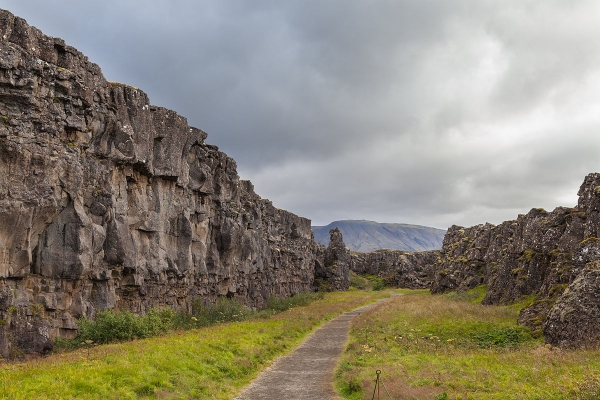
During the Viking Age commonwealth parliament remained in session for a couple of weeks. With hundreds, even thousands, of people gathered at Alþingi it as the centre of life in Iceland. Tents and huts were erected in the fields below Almannagjá gorge to house the guests.
In addition to a legislative assembly Alþingi was a court, and a gathering of the entire nation, where deals were struck, alliances formed and feasts held. Some of the most important scenes in the Sagas take place at Alþingi. It was the focal point of Viking Age Iceland.
Read more: 7 things you didn't know about Alþingishúsið, the house of parliament
Alþingin continued to meet in Þingvellir until 1798. It 1844 it was moved to Reykjavík, finally receiving a permanent home in downtown Reykjavík in the newly erected house of parliament in 1881.
5) It is constantly expanding
The entire Þingvellir region is located in a rift valley created by the drifting apart of the North American and Eurasian tectonic plates.
The tectonic plates are drifting in opposite direction at the rate of 2cm (0.8 in) annually.
The plate boundary runs through Iceland. In Reykjanes peninsula the plates inch past each other at a constant rate, but at Þingvellir, they move in opposite directions, breaking apart. This causes the land between them to subside.
Read more: Beautiful video of snorkelling in crystal clear waters in lava fissure in Þingvellir national park
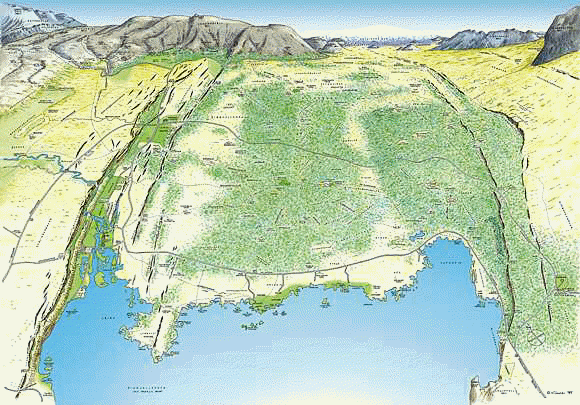
The 7.7 km (4.8 mile) long Almannagjá gorge on the west edge of the Þingvellir National Park, where the Viking age commonwealth parliament Alþingi met, marks the western edge of the valley. Heiðagjá gorge on the east edge of Þingvellir marks the eastern edge of the rift valley.
6) You can dive between the continents
The many gorges have filled with crystal clear spring water. The water has been filtered by the lava and volcanic rocks, which it seeps through on its way down from the mountains and Langjökull glacier to the north of Þingvellir.
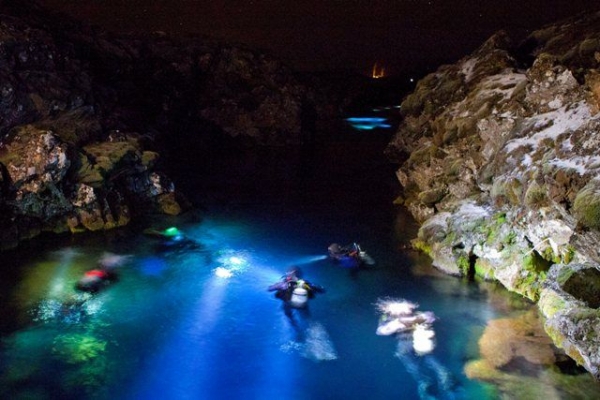
One of the gorges, Silfra, has become a popular destination for travellers who snorkel or dive in its clear water, enjoying the view of beautiful natural formations in the gorge and the amazing feeling of swimming right between the two continental plates.
7) The valley is subsiding and expanding
The valley has subsided by at least 4 meters (12 ft) since Iceland was settled. As the entire rift valley has subsided the shore of the lake has moved further to the North. At the same time the valley edges have drifted apart. The expansion of the valley since Iceland was settled is somewhere around 8.5 meters (28 ft).
The movement of the tectonic plates is not constant in Þingvellir, as it is in Reykjanes peninsula. At Þingvellir the movement takes place in busts, as tensions build up and the movement taking place in bursts of major earthquakes and subsiding of the valley.
Read more: Powerful earthquake swarm south of Þingvellir over after 170 quakes: What happened?

The most recent burst of activity swept over Þingvellir in spring 1789. The valley subsided 1-2 meters (3-6 ft) during this episode. Periodically the valley has then been filled with lava in eruptions of nearby volcanoes. The last eruption took place 2000 years ago.
The entire area is still highly active geologically and the question is not whether, but when, the next major eruption takes place.
8) Þingvallavatn lake: Iceland’s largest lake
In the southern part of the valley is Þingvallavatn lake. With a surface area of 84 km2 and a depth of 114 m (374 ft) it is the largest natural lake in Iceland. One river runs into Þingvallavatn, Öxará, which runs through Almannagjá gorge, but it is primarily fed by groundwater.
The majority of the catchment area is covered by lava and water easily drains through. The young age of the lava means that there is a high uptake of minerals in the groundwater, and this is one of the reasons for the great diversity of life in Þingvallavatn.
The lake is particularly fertile and rich in vegetation, despite the very cold temperatures. A total of 150 types of plants have been found and 50 kinds of invertebrates, from the shore to the center.
9) Unique char popularion
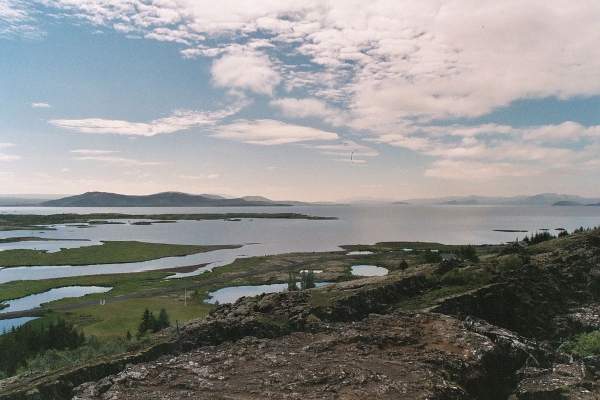
The Arctic Charr population of Þingvallvatn is completely unique in the world, as no lake is home to as many distinct types (morphs) of charr. Four different types of Arctic Charr live in Þingvallvatn, each adapted to a specific habitat in the lake.
The char Lake Þingvallavatn have evolved and adapted to their surroundings since the population became isolated at the end of the last Ice Age, 10,000 years ago.
Arctic charr is a cold-water fish in the family Salmonidae, (Salmon and trout also belong to the salmonidae family). Char are native to alpine and subarctic lakes as well as arctic and subarctic coastal waters. In Icelandic char is called Bleikja, a feminine form of the word for the color pink, bleikur.
Read more: Þingvellir featured in first episode of Season 4 of Game of Thrones
The four types of char in Þingvallavatn are Silableikja, a fish-eating type, piscivorous charr which lives close to the surface and in shallow regions. It can grow up to 40 centimetres in length. A second type of char shares this habitat, but primarily eats plants, Murta, the plant-eating, or planktivorous charr. It is significantly smaller, usually only about 20 centimetres in length.
The lake bottom, which is rich in food and places to hide from predators, is the main habitat of the large snail-eating charr and a morph of dwarf-charr. The snail-eating charr can grow to be up to 50 centimetres in length, while the dwarf-charr is usually only 10-13 centimetres.
